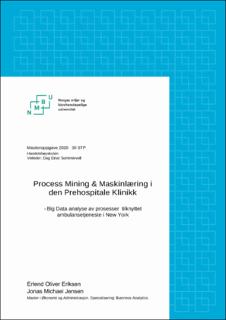| dc.contributor.advisor | Sommervoll, Dag Einar | |
| dc.contributor.author | Jensen, Jonas Michael | |
| dc.contributor.author | Eriksen, Erlend Oliver | |
| dc.coverage.spatial | USA, New York | en_US |
| dc.date.accessioned | 2020-11-23T15:20:43Z | |
| dc.date.available | 2020-11-23T15:20:43Z | |
| dc.date.issued | 2020 | |
| dc.identifier.uri | https://hdl.handle.net/11250/2689179 | |
| dc.description.abstract | Helsetjenesten er en viktig del av samfunnet. Den mye omtalte eldrebølgen vil øke behovet for helsetjenester, og når uventede pandemier oppstår, så er helsetjenesten en utsatt del i samfunnet. Behovet for effektivisering er ofte et diskutert tema, og datanalyse metoder kan være en del av løsningen. Om dataanalyse metoder har potensiale, må slike metoder utprøves i kontekst av helsesektoren, og da helse relatert data. Studien tar til sikte på å uthente, og studere informasjon om prosesser og aktiviteter - i New York, Manhattan. Dataene som brukes i studien er fra New York sin ambulansetjeneste. Dette innebærer alle aktiviteter fra når en borger ringer inn til nødsentralen for hjelp, og til det tidspunkt når borgeren eventuelt blir brakt med til sykehuset. Dataene omhandler hjertestans pasienter. Studien bruker metodene Process Mining og Maskinlæring for å uthente informasjon om dataene. Ved bruk av Process Mining algoritmen, alfa pluss, ble en prosessmodell (Petri net) produsert. Petri net modellen tok til sikte på å fremheve aktivitetene som er tilknyttet ambulanseutrykninger, i tidsperioden 2008 til 2019. Måltall i studien ble brukt til å vurdere modellkvalitet. Måltallene som ble brukt var precision, generalization, fitness og simplicity. Måltallene i studien kommuniserte at modellen hadde i stor grad fanget opp mye viktig informasjon i dataene, der gjennomsnitt score til måltallene ble 90.38%, av maksimalt 100%.
Ved bruk av Maskinlæring ble flere algoritmer brukt for å lage en modell som hadde til hensikt å estimere den totale tidsbruken til én case (gjennomstrømstid). Samme datagrunnlag som ble brukt for Process Mining ble brukt i Maskinlæring. Den beste algoritmen for prediksjon av gjennomstrømstid var modellen basert på XGBoost. Modellen ble trenet ved hjelp av repetert kryssvalidering, der tilfeldig søk ble andvendt for å finne de optimale hyperparameterene. XGBoost fikk en MAE på 627. | en_US |
| dc.description.abstract | The health service is an important part of society. The much discussed wave of the elderly will increase the need for health services, and when unexpected pandemics occur, the health service is a vulnerable part of society. The need for efficiency is often a discussed topic, and data analysis techniques can be part of the solution. If data analysis methods have potential - such methods must be tested in the context of the health sector, and with health related data. This study aims to retrieve and study information about processes and activities - in New York, Manhattan. The data used in the study is from New York's ambulance service. This involves all activities from when a citizen calls to the emergency center for help, and to the time when the citizen is possibly brought to the hospital. The data addresses cardiac arrest patients. The study uses Process Mining and Machine Learning methods to retrieve information about the data. Using the Process Mining algorithm, alpha plus, a process model (Petri net) was produced. The Petri net model aimed to highlight the activities associated with ambulance calls, during the period 2008 to 2019. Targets in the study were used to assess model quality. The target figures used were precision, generalization, fitness and simplicity. The result communicated that the model had largely captured much of the important information in the data. The average score was 90.38 %, of a maximum of 100 %.
When using Machine Learning, several algorithms were used to create a model that was intended to estimate the total time spent on a case (throughput time). The same data was used for Machine Learning as in Process Mining. The best algorithm for prediction of throughput time was the model based on XGBoost. The model was trained using repeated cross validation and random search was used to find the optimal hyperparameters. XGBoost received an MAE of 627. | en_US |
| dc.language.iso | nob | en_US |
| dc.publisher | Norwegian University of Life Sciences, Ås | en_US |
| dc.rights | Attribution-NonCommercial-NoDerivatives 4.0 Internasjonal | * |
| dc.rights.uri | http://creativecommons.org/licenses/by-nc-nd/4.0/deed.no | * |
| dc.subject | Process mining | en_US |
| dc.subject | Maskinlæring | en_US |
| dc.subject | Pre hospital | en_US |
| dc.title | Process mining & maskinlæring i den prehospitale klinikk : big data analyse av prosesser tilknyttet ambulansetjeneste i New York | en_US |
| dc.type | Master thesis | en_US |
| dc.subject.nsi | 210: Bedriftsøkonomi | en_US |
| dc.source.pagenumber | 111 | en_US |
| dc.description.localcode | M-ØA | en_US |

